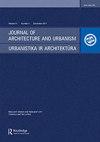测量城市空间中的地方依恋、身份和记忆:以巴基斯坦拉合尔的城墙城为例
IF 0.8
0 ARCHITECTURE
引用次数: 3
摘要
公共空间对任何城市来说都是必不可少的,因为它们定义了地方特征;它们是社会和文化活动的交汇点。地点依恋是由个人和地点之间的联系所塑造的。研究考察了历史悠久的街道,这些街道是他们时期的遗迹,当时行人流量占主导地位,具有支持社会行动的特殊品质。如今环境的变化可能改变了人们的看法,调查是为了质疑和检查个人的共同记忆以及他们与历史街道的敏感联系。拉合尔城墙城的四条街道是根据它们的历史意义和用途选择的。编制问卷,进行面对面的实地调查,并对选定的街道进行地点依恋、身份认同和记忆方面的调查。结果证明,对选定的街道有一种有希望的依恋感,如果仔细观察有价值的街道,可以改善街道缺乏的品质。这项研究解决了边缘化的重要问题,Shah-Almi街道的结果表明,他们的行为将使有围墙的城市街道失去其身份,因为它是由其用户形成的。本文章由计算机程序翻译,如有差异,请以英文原文为准。
MEASURING PLACE ATTACHMENT, IDENTITY, AND MEMORY IN URBAN SPACES: CASE OF THE WALLED CITY OF LAHORE, PAKISTAN
Public spaces are essential for any city as they define place character; they are the meeting point for social and cultural actions. Place attachment is moulded by the tie between individuals and places. The research examines the historic streets, which are remainders of their period when the pedestrian flow was predominant and had exceptional qualities that supported social action. The changed settings nowadays might have changed people’s views and the investigation was made to question and check individual’s common memory and their sensitive ties to the historic streets. The four streets from the Walled City of Lahore were selected upon their significance of history and usage. The questionnaires were prepared and the fieldwork analysis was conducted face to face and selected streets were investigated in the terms of, place attachment, identity, and memory. The outcome proved that there is a promising feeling of attachment towards the selected streets and lacking qualities of a street can be improved if look closely at the worthy streets. The study addressed an important issue of marginalization and the results from the Shah-Almi street shows that their act will create the walled city streets to lose their identity as it is formed by its users.
求助全文
通过发布文献求助,成功后即可免费获取论文全文。
去求助
来源期刊

Journal of Architecture and Urbanism
ARCHITECTURE-
CiteScore
1.30
自引率
14.30%
发文量
12
审稿时长
15 weeks
期刊介绍:
The Journal of Architecture and Urbanism publishes original research on all aspects of urban architecture.
 求助内容:
求助内容: 应助结果提醒方式:
应助结果提醒方式:


